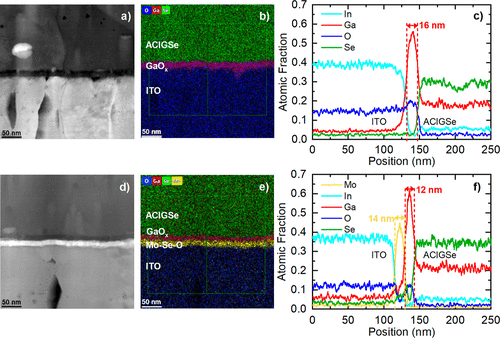SITA’s Interface Innovation Unlocks 10% Efficiency for Transparent Solar Cells
HAADF-STEM bright-field images (a,d), EDS-derived chemical maps (b,e), and EDS line profiles (c,f) of the ACIGSe-based solar cell layer stack with ITO (a, b, c) and thin Mo/ITO (d, e, f) back contacts, respectively.
A minimal addition—just 10 nanometres of molybdenum—has led to a major performance gain in transparent wide band-gap solar cells, reinforcing the importance of interface design in advanced photovoltaic devices.
A recent publication in ACS Applied Materials & Interfaces, co-authored by SITA partners from HZB, ZSW, and INL, reports a significant advancement in the development of wide band-gap Cu(In,Ga)Se₂-based (ACIGSe) solar cells—an essential component for tandem photovoltaics. The study, titled “Impact of a Thin Sacrificial Mo Layer on the Formation of the Wide Band Gap ACIGSe Absorber/ITO Thin-Film Solar Cell Interface”, addresses a key bottleneck in the design of transparent top cells.
Transparent conductive oxide (TCO) contacts like ITO are critical for tandem integration, but in wide band-gap absorbers, they often cause performance loss due to the formation of gallium oxide (GaOx) at the interface. This new work demonstrates that inserting a thin sacrificial Mo layer not only suppresses GaOx formation but promotes beneficial layers of MoSe₂ and MoOx, which serve as effective hole-selective contacts.
The result is remarkable: solar cell efficiency increases from <1% to 10.1%, with a threefold boost in fill factor. These improvements were confirmed using advanced STEM-EDS and HAXPES characterisation techniques, offering new insights into the chemical and electronic structure of this critical interface.
This innovation supports the SITA project’s mission to develop stable, scalable, and high-efficiency tandem solar cells. By enhancing both transparency and performance of wide band-gap top cells, the findings move the project closer to its target of >30% tandem device efficiency with long-term durability.

